Montepulciano
The steep climb up Via del Teatro is rewarded by the sudden, unexpected appearance of Piazza Grande. This square is the main reason why Montepulciano is known as “the pearl of the 16th Century”, the centre of Tuscan Renaissance.
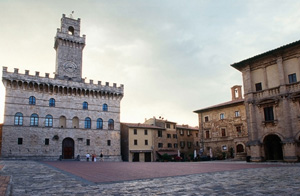 This piazza, entirely surrounded by masterpieces of Renaissance architecture, has managed to preserve its original atmosphere. Right in front of you, you will see the Palazzo Comunale, designed by Michelozzo. Palazzo Contucci, Palazzo del Capitano and Palazzo dei Nobili are arrayed along another two sides, while the fourth side is occupied by the unfinished facade of the Cathedral. This could also be called a museum, due to the many works of art it contains. These include the famous Triptych of the Assumption by Taddeo di Bartolo and many other equally celebrated works,such as the Aragazzi Cenotaph by Michelozzo, a Madonna and Child by Sano di Pietro, a baptismal font byTino da Camaino, an altar front in glazed terracotta by Andrea della Robbia and so many others. This piazza, entirely surrounded by masterpieces of Renaissance architecture, has managed to preserve its original atmosphere. Right in front of you, you will see the Palazzo Comunale, designed by Michelozzo. Palazzo Contucci, Palazzo del Capitano and Palazzo dei Nobili are arrayed along another two sides, while the fourth side is occupied by the unfinished facade of the Cathedral. This could also be called a museum, due to the many works of art it contains. These include the famous Triptych of the Assumption by Taddeo di Bartolo and many other equally celebrated works,such as the Aragazzi Cenotaph by Michelozzo, a Madonna and Child by Sano di Pietro, a baptismal font byTino da Camaino, an altar front in glazed terracotta by Andrea della Robbia and so many others.
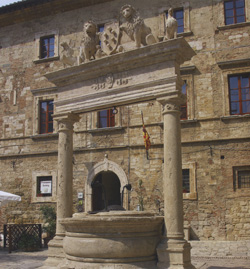 The oldest part of the town spreads over the entire hill and, in addition to the noble buildings already mentioned, it is crammed with innumerable historically and artistically important edifices, such as the church of Sant’Agostino (also designed by Michelozzo), the church of Santa Lucia, which contains a painted panel thought to be the work of Signorelli, and the church of Gesu’, with the interior and vaults designed in 1700 by Andrea Pozzo. This artist was particularly active in Montepulciano. In the church of Santa Maria dei Servi, there is also a painted panel attributed to Duccio di Buoninsegna, who was one of Siena’s greatest 14th Century artists. The oldest part of the town spreads over the entire hill and, in addition to the noble buildings already mentioned, it is crammed with innumerable historically and artistically important edifices, such as the church of Sant’Agostino (also designed by Michelozzo), the church of Santa Lucia, which contains a painted panel thought to be the work of Signorelli, and the church of Gesu’, with the interior and vaults designed in 1700 by Andrea Pozzo. This artist was particularly active in Montepulciano. In the church of Santa Maria dei Servi, there is also a painted panel attributed to Duccio di Buoninsegna, who was one of Siena’s greatest 14th Century artists.
The main streets of Montepulciano are lined with historic buildings, such as the unadorned Palazzo Cervini, which now houses a bank, Palazzo Grugni, which was possibly designed by Vignola, Palazzo Cocconi, attributed to Antonio da Sangallo the Elder, and the Fortress, built on the summit of the hill on the remains of the original “Castrum Politianum”. Palazzo Buccelli has a particularly striking facade. The original owner, Pietro Buccelli, was a scholar and antique collector, who filled his home with a large collection of Etruscan artefacts. The objects he considered of little importance, including funeral urns, inscriptions and fragments of tombstones, were used to cover the bottom of the external walls of the palazzo, thus creating a kind of open-air museum.
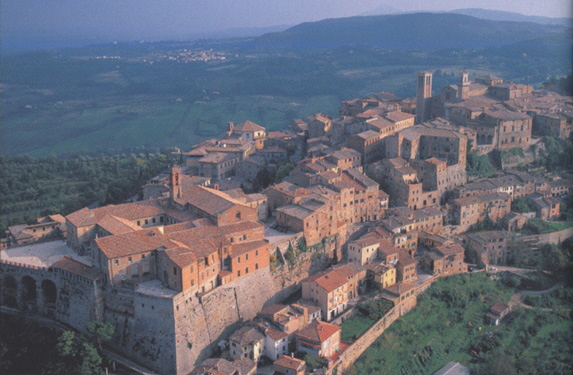 |
Every part of Montepulciano, however, is worth visiting. You can get glimpses of breathtaking views from many corners and little piazzas. Perhaps the most beautiful view is from Piazza San Francesco. The imposing and elegant Tempio di San Biagio is situated down in the valley under Montepulciano.
Built by Antonio da Sangallo the Elder, one of the most important architect of the period, this church is a typical example of Renaissance architecture. From the sacred to the profane: a visit to few of the renowned wine cellars is a must. Quite apart from their normal role, they are also of historic interest. Some of them have been selling wine for centuries and they fill much of the subterranean area underneath the town.
The Vino Nobile di Montepulciano
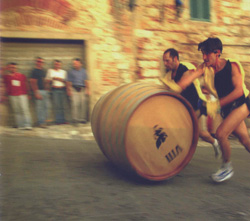 The Vino Nobile di Montepulciano is made from a special type of Sangiovese grape. It is with no doubt one of the region’s most prominent reds and consequently one of the world’s most important wines. It has, like many products of the Val di Chiana, kept a healty balance between quality and price. The Vino Nobile di Montepulciano is made from a special type of Sangiovese grape. It is with no doubt one of the region’s most prominent reds and consequently one of the world’s most important wines. It has, like many products of the Val di Chiana, kept a healty balance between quality and price.
An overview of Montepulciano would not be complete without tasting its wine and the centrepiece of a Renaissance pageant, the Bravio delle Botti, a unique palio staged in its medieval streets.
The Sights of Montepulciano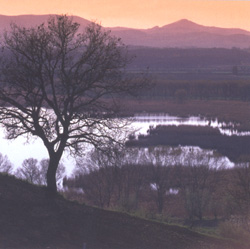
The pearl of the sixteenth century, a jewel of a town: Renaissance Montepulciano has been the subject of thousands of books.
The town has a vast municipal territory that includes a large part of the Sienese Val di Chiana.
In the heart of the valley is set a small expanse of water, Lake Montepulciano, one of Italy’s most important wetlands, where more then 130 migratory and indigenous bird species, many of them rare, find shelter. A visitor centre has been created on its shore in conjunction with a system of strategic observation points.
The Museo Civico Pinacoteca Crociani
Via Ricci, 10 - Tel +39 0578 717300
The museum is subdivided into various sections and displays many important pieces. To be enjoyed are sixteenth and seventeenth-century terracotta of the school of Andrea della Robbia, and various pictorial masterpieces from the 14th Century Sienese school. The museum also houses valuable illustrated choir-books of the Florentine school, eighteenth-century silver objects and a rich collection of the contents of Etruscan and Roman tombs.
Population:
Local market: Thursday morning
|

